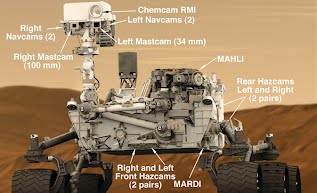by: Nicole Willett
For centuries there has been speculation about life on Mars, from microbes to little green men. Scientists have spent an enormous amount of time and resources searching for clues to previous or current life on the Red Planet. The latest mission to search for the clues to life on Mars is NASA’s Mars Science Laboratory (MSL) Curiosity.
With much fanfare, on August 5, 2012, the MSL Curiosity landed successfully in Gale Crater on Mars. The landing site was named Bradbury Landing site in honor of the late science fiction author Ray Bradbury. There have been many predecessors to the Curiosity Rover on Mars, including orbiters, rovers, and landers. Over the past few years NASA has been using the “follow the water” strategy in an effort to find evidence of past or current life on Mars. We know that everywhere we have water on Earth we have life.
The Viking 1 & 2 landed on Mars in 1976. The main purpose of the scientific experiments was to search for life. The first soil test for Viking yielded positive results for life, however the tests that followed all yielded negative results. These results are controversial and are still being studied and debated to this day. Another important finding from the Viking missions was that water vapor was released from the soil samples that were heated in the gas chromatograph mass spectrometer.
The Pathfinder Sojourner Rover landed on July 4, 1997. The Sojourner Rover was the first rover deployed on another planet. The X-ray spectrometer examined the soil and determined that Mars clearly had a warmer and wetter past. The Sojourner Rover confirmed previous volcanic activity by discovering basaltic rock. Scientists state that volcanic ash increases soil fertility. The rover also found many elements including magnetite. The discovery of magnetite is important because it is found on Earth in bacteria, brains of bees, termites, fish, mollusk teeth, some birds, and humans. Scientists must use Earth as an analog for any discoveries made on Mars.
The European Space Agency launched the spacecraft, Mars Express, which arrived at the Red Planet in December 2003. This orbiter is tasked with high resolution imaging of the entire surface as well as mapping the mineral and atmospheric composition. The information gained from Mars Express helps space agencies determine landing sites for future rovers and landers.
The Mars Exploration Rovers (MER) Spirit and Opportunity landed on Mars three weeks apart in early 2004. These two wonderful rovers were scheduled to work only 90 days, which they far exceeded. Spirit landed January 4, 2004 and sent its last communication to Earth March 22, 2010. The Opportunity Rover landed on January 25, 2004 and continues to roam the Martian surface. The twin rovers were sent to assess habitability and evidence of past water. Both have discovered evidence of past water on Mars. One discovery was hematite, a mineral that forms in the presence of standing water over a long period of time. The principal investigator for the MER’s, Steven Squyres, has stated that not only did Mars have water, but it had at one time large quantities of water on its surface.
The Phoenix Lander arrived on the surface of the Red Planet in the north polar region on May 25, 2008. Phoenix was searching for environments suitable for microbial life. Phoenix discovered water ice and when scientists watched as it sublimated in front of the lander’s cameras. Phoenix’s wet chemistry lab tested the ingredients of the soil and found perchlorate (ClO4). This chemical could be used by future colonists for everything from rocket fuel and a source of oxygen.
The Mars Society Convention hall, in Pasadena, was filled as we watched Curiosity land flawlessly in Gale Crater on August 5, 2012. The rover landed to a worldwide audience anxiously watching. This landing site was picked for many reasons, such as, the alluvial fan (ancient river delta), the depth of the crater, and the height of the peak (Mount Sharp). Curiosity is equipped with 17 cameras, an entire science laboratory, and is tasked with assessing the habitability of Mars.
Previous missions have found elements in the atmosphere and in the soil as well as previous liquid water which are all clues to previous life on Mars. One piece of evidence still missing from the puzzle is organic carbon. Curiosity’s Sample Analysis at Mars (SAM) is a suite of instruments that will analyze the contents of the Martian soil. SAM will look for carbon containing compounds and other elements associated with life, such as, hydrogen, nitrogen, and oxygen. Scientists are hoping to find organic carbon with a biological origin. If found this will have to be studied and tested many times to prove what the origin actually is. There will likely be debates about whatever Curiosity finds until there is unequivocal inarguable evidence.
On October 8, 2012 the Curiosity Rover, scratched the surface of Mars, scooping up its first soil in order to clean the inside of the rovers sample handling mechanism. The sample will be shaken vigorously and then emptied onto the ground. This procedure will be repeated several times. The cleaning is to ensure that any contaminants left over from Earth will be discarded before any true testing takes place. Once the instruments are cleaned and the soil tests take place, they will determine whether or not the area was once a favorable environment for microbial life. Curiosity is equipped with more scientific instruments than any spacecraft deployed on Mars. Her planned two year mission is sure to make many wonderful discoveries.


